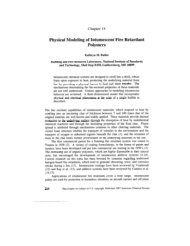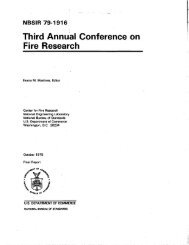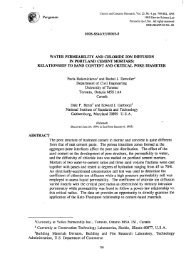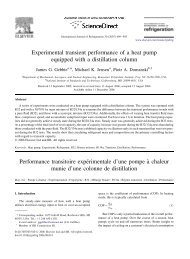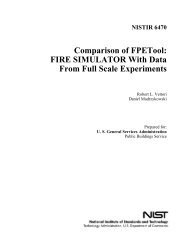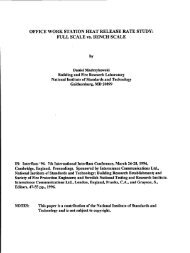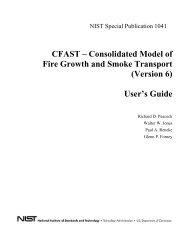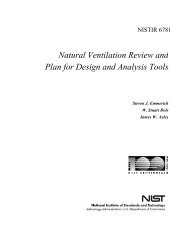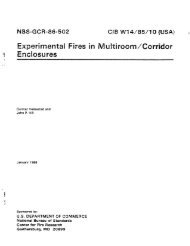Study of Technology for Detecting Pre-Ignition Conditions of ... - NIST
Study of Technology for Detecting Pre-Ignition Conditions of ... - NIST
Study of Technology for Detecting Pre-Ignition Conditions of ... - NIST
Create successful ePaper yourself
Turn your PDF publications into a flip-book with our unique Google optimized e-Paper software.
CPSC-IAG95-1145<br />
Figure 30 shows the total hyh-oca.rlxm ad water areas as a function <strong>of</strong> time fen-a test <strong>of</strong><br />
~~]~ea~e~ on ~ elec~ic range with the range hood <strong>of</strong>f. Hydrocarbon area is the area under the<br />
hydrocarbon spectral peak integrated from 2782 cm-l to 3029 cm-l. Thk frequency range<br />
corresponds to the spectral band produced by the stretching <strong>of</strong> carbon-hydrogen bonds in alkanes,<br />
alkenes, and aromatic hydrocarbons. 9 The limited spectral resolution <strong>of</strong> the instrument and the<br />
likely overlap and interference <strong>of</strong> the spectra <strong>of</strong> many hydrocarbons prevented fi.uther<br />
identification <strong>of</strong> specific organic compounds within the broad peak. The hydrocarbon curve rises<br />
sharply in a manner similar to the laser attenuation curves. The water area is the area under the<br />
water spectral peak integrated from 1644 cm-l to 1755 cm-l. Water increases more gradually<br />
than the hydrocarbons and peaks at one fourth <strong>of</strong> the hydrocarbon amount.<br />
Figure 31 shows a wmparison <strong>of</strong> the hydrocarbon-area measurements <strong>for</strong> all <strong>of</strong> the food<br />
and range-hood combinations heated cm the electric range- Sugar produces similar levels <strong>of</strong><br />
hydrocarbons to those produced by the other foods, but in a shorter period <strong>of</strong> time. The CWVeS<br />
closely resemble those <strong>for</strong> laser attenuation except sugar generates the most hydrocarbons,<br />
followed by bacon and oil.<br />
Figure 32 shows a comparison <strong>of</strong> the hydrocarbon-area measurements <strong>for</strong> all <strong>of</strong> the food<br />
and range combinations heated on the high-output gas range. The gas range seems to produce<br />
similar levels <strong>of</strong> hydrocarbons from heating food to those produced by the electric range. The<br />
coarse time resolution <strong>of</strong> these measurements makes it difficult to accurately compare the<br />
maximum levels since the last spectral scans be<strong>for</strong>e ignition are averaged with scans tier<br />
ignition, The data points shown are those averages that were not tainted by post-ignition scans,<br />
Figure 33 shows a comparison <strong>of</strong> the water-area measurements <strong>for</strong> all <strong>of</strong> the food and<br />
range-hood combinations heated on the electric range. The heating <strong>of</strong> sugar produces much more<br />
water than either bacon or oil due to the breakdown <strong>of</strong> the chemical structure <strong>of</strong> sucrose. For<br />
bacon, water initially boils <strong>of</strong>f due to the water content <strong>of</strong> the meat, and then more water vapor<br />
<strong>for</strong>ms later as a pyrolysis product. Heating <strong>of</strong> the oil produces no water initially, but increasing<br />
amounts <strong>for</strong>m as some components <strong>of</strong> the oil begin to break down.<br />
Figure 34 shows a comparison <strong>of</strong> the water-area measurements <strong>for</strong> all <strong>of</strong> the food and<br />
range combinations heated on the high-output gas range. Water was measured immediately upon<br />
the start <strong>of</strong> each test using the gas range. This is due to the addition <strong>of</strong> a constant level <strong>of</strong> water<br />
vapor from combustion <strong>of</strong> the burner flame to the water contributed from the foods.<br />
~ ef<strong>for</strong>t was made to generate Coz mea cu~es by integrating the C02 SPeCtral band<br />
from 2320 cm-l to 2383 cm-]. The results initially seemed nonphysical because <strong>of</strong> negative areas<br />
which implied a decrease in C02 from ambient levels. One possible explanation is that little or<br />
no air, which contains C02 on the order <strong>of</strong> several hundred ppm, WaS en~ained by the PIume ~d<br />
passed by the FTIR beam in the section <strong>of</strong> the path length over the pan. Thk would cause less<br />
C02 to be measured during the experiments than was measured as background levels. Since the<br />
background data were subtracted from the experimental da@ negative areas resulted. Another<br />
explanation is that the increased temperature <strong>of</strong> the plume relative to the cool background caused<br />
the C02 molecules to spread apart, and the decreased number density <strong>of</strong> COZ molecules was<br />
interpreted as an absolute decrease in C02 by the FTIR. A third possibility is that the increase<br />
in plume temperature during the test over the ambient background temperature produced enough<br />
additional infrared radiation from the plume to cause the relative absorbance by C02 in the hot<br />
49



